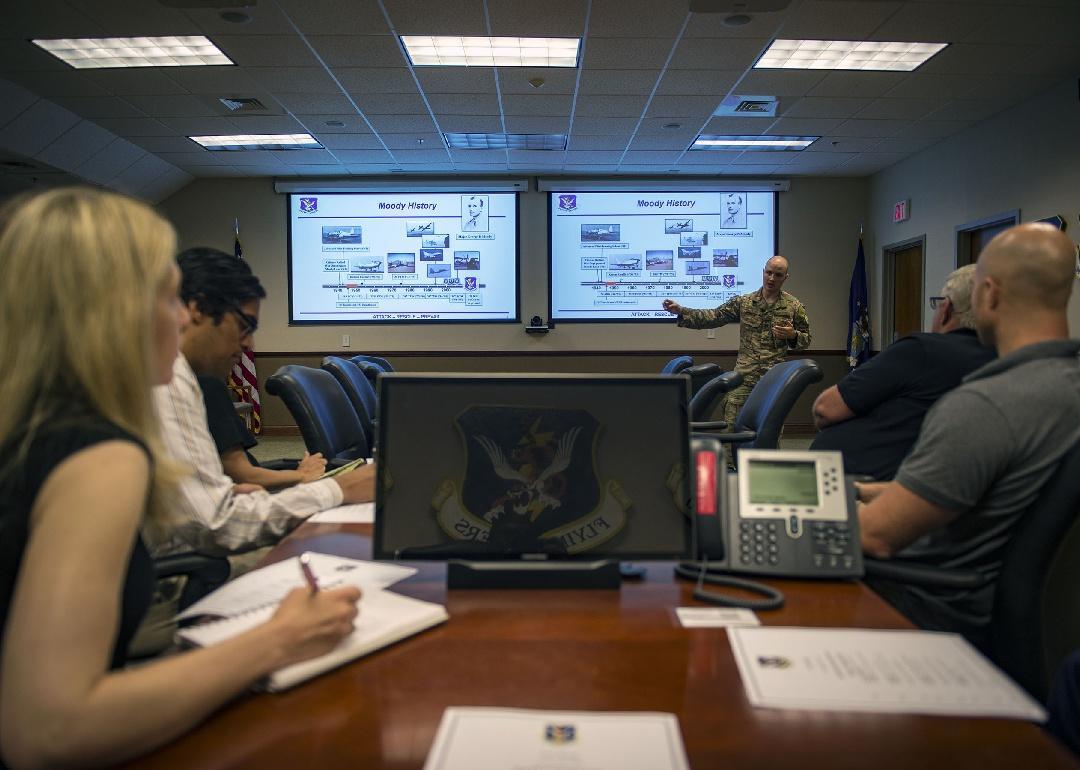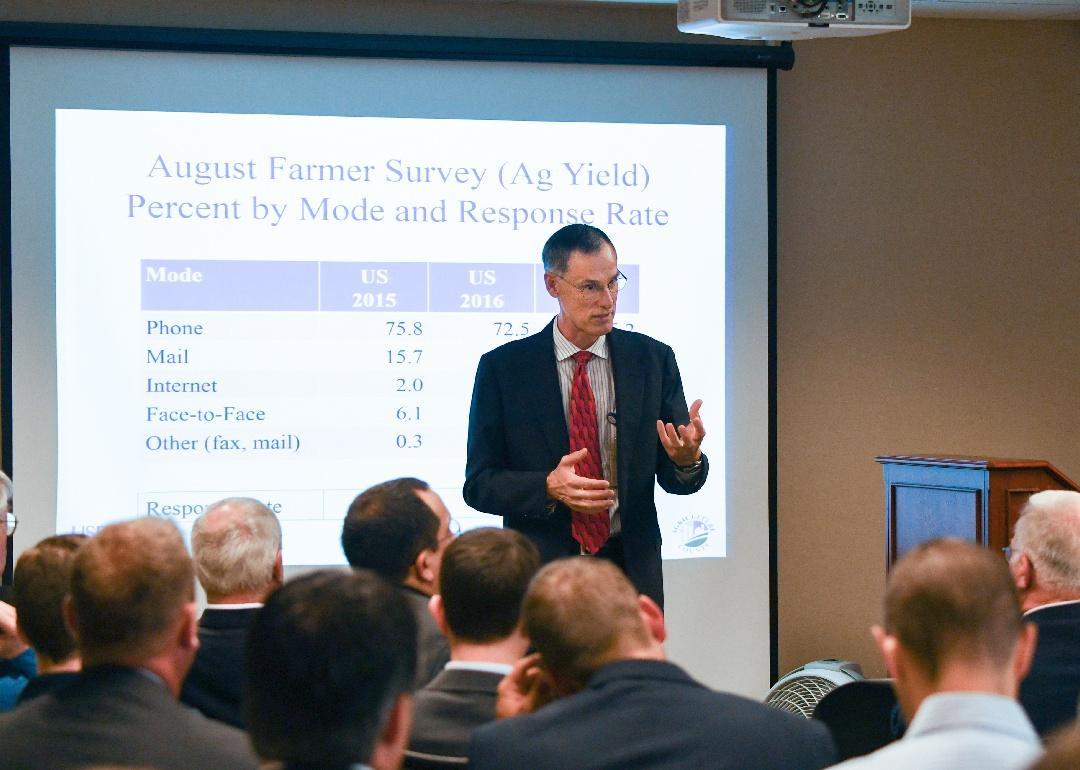Business
Jobs projected to grow the most in the next decade
Published
1 year agoon

With the pace of work speeding up, and demands on workers and companies ever-changing, it’s no secret the jobs of the future will be quite different from today’s jobs, much less the jobs of the past. Although technology has been a significant factor in changing many workplaces in the United States, the tech industry is slated to grow slower than some other key industries.
Stacker compiled a list of 30 jobs expected to grow the most by 2031, using Bureau of Labor Statistics Employment Projections data current as of Sept. 8, 2022. Jobs are ranked by the percentage difference between actual 2021 employment figures and projected employment figures for 2031. Ties are broken by a field’s number of overall projected jobs in 2031.
The health care sector is expected to experience a boom in the next decade. In fact, the top three fastest-growing industries—specialty hospitals, home health care services, and health care practitioner offices—all fall under its umbrella. Other industries that made the top 10 for the next decade include power communication line construction, electronic shopping, and financial investment.
It’s also worth noting that many of the jobs on this list virtually disappeared during the pandemic—jobs like ushers, lobby attendants, and ticket takers—so their expected growth may be due less to new opportunities by 2031 than the fact that there were so few of those jobs in 2021.
By 2030, experts also predict job seekers will need a whole new host of skills to impress their potential employers. Future skills include digital literacy, emotional and social intelligence, computational thinking, and cognitive flexibility. Taken together, these traits could signal both that top job applicants must be willing to adapt to a rapidly changing environment and that human value—like a warm bedside manner—can’t simply be replaced by automation.
You may also like: States with the most farmland
![]()

Said M // Shutterstock
#30. Roustabouts, oil and gas
– 2021-2031 projected employment change: +8,600 (23.0% change)
– 2021 employment: 37,300
– Projected 2031 employment: 45,900
– Projected annual job openings: 5,600
While the barrier to entry is very low, being a roustabout—a laborer without specific technical skills—requires a good deal of physical stamina. However, suppose you can withstand the physicality and long hours. In that case, you can have an exciting career dismantling machinery and doing other physical work on oil and gas drilling, refining, and distribution sites.
Senior Airman Greg Nash // U.S. Air Force
#29. Entertainment attendants and related workers, all other
– 2021-2031 projected employment change: +1,100 (23.2% change)
– 2021 employment: 4,700
– Projected 2031 employment: 5,800
– Projected annual job openings: 1,500
Whether working with crowds at amusement parks or maintaining a bowling alley, entertainment attendants can enter the industry with no advanced degree and minimal experience. If you are a friendly person with the ability to handle large groups of people, you can enter this industry easily.

Semiglass // Shutterstock
#28. Operations research analysts
– 2021-2031 projected employment change: +24,200 (23.2% change)
– 2021 employment: 104,200
– Projected 2031 employment: 128,300
– Projected annual job openings: 10,300
Operations research analysts work with mathematical models and complex analytic methods to help companies produce top-notch solutions and solve problems. The demand for operations research analysts is already high in the biotech industry and is expected to increase: The job represents one of the six most in-demand biopharmaceutical careers. The median annual salary for an operations research analyst in the biopharma industry is $83,890.
Ness Kerton/AusAID // Flickr
#27. Health specialties teachers, postsecondary
– 2021-2031 projected employment change: +59,400 (24.1% change)
– 2021 employment: 246,700
– Projected 2031 employment: 306,100
– Projected annual job openings: 28,900
Postsecondary health specialties teachers instruct college-level courses on topics like dentistry, medicine, pharmacy, public health, and veterinary medicine. Employment of postsecondary teachers will rise as enrollment at postsecondary schools is projected to increase, though some postsecondary instructors are expected to be employed only part-time. The average annual salary for a postsecondary health specialty teacher is $122,320.

Artur Didyk // Shutterstock
#26. Dancers
– 2021-2031 projected employment change: +1,500 (24.5% change)
– 2021 employment: 6,200
– Projected 2031 employment: 7,700
– Projected annual job openings: 1,300
When the COVID-19 pandemic began, many dancers had to look for creative ways to make money. For some, a change meant switching to administrative or consultation roles, while others were able to enjoy a less formal way of dance. Due to the proliferation of recording performances on video during the pandemic, the industry continues to grow an expected 27% from 2021 to 2031.

Canva
#25. Personal care and service workers, all other
– 2021-2031 projected employment change: +26,000 (24.9% change)
– 2021 employment: 104,400
– Projected 2031 employment: 130,400
– Projected annual job openings: 22,600
The personal care industry is thriving now that the public is allowed back in salons and spas without restrictions. During the early days of the pandemic, salons saw an increase in sales after exploring technologies to book in-home visits and schedule storefront appointments. As a result of new service options and reviving demand, the personal care industry is slated to grow 14% between 2021 and 2031.

Canva
#24. Occupational therapy assistants
– 2021-2031 projected employment change: +11,000 (25.4% change)
– 2021 employment: 43,400
– Projected 2031 employment: 54,500
– Projected annual job openings: 8,700
The job outlook for occupational therapy assistants is very positive, and occupational therapy assistant jobs are expected to grow steadily for the foreseeable future. Those considering a career in occupational therapy can expect to work with people of all ages and have tremendous career flexibility, with opportunities to work with children, people with disabilities, students, or people with behavioral issues.
ALPA PROD // Shutterstock
#23. Home health and personal care aides
– 2021-2031 projected employment change: +924,000 (25.4% change)
– 2021 employment: 3,636,900
– Projected 2031 employment: 4,560,900
– Projected annual job openings: 711,700
There is a significant shortage of home health care workers because of the pandemic. But the industry requires minimal on-the-job training, so it’s an excellent opportunity for anyone looking to change their career.

Canva
#22. Epidemiologists
– 2021-2031 projected employment change: +2,200 (25.8% change)
– 2021 employment: 8,600
– Projected 2031 employment: 10,900
– Projected annual job openings: 800
Epidemiologists are important workers during a pandemic because they study and determine the causes of a disease’s spread. Through online tech platforms, including websites where preliminary research can be quickly publicized, scientists can now communicate faster and share results across time zones.

Canva
#21. Software developers
– 2021-2031 projected employment change: +370,600 (26.0% change)
– 2021 employment: 1,425,900
– Projected 2031 employment: 1,796,500
– Projected annual job openings: 143,400
The pandemic increased software jobs and accessibility for those who want to learn how to program. This means there is a lot of job security in this field. Furthermore, with the increase in cyberattacks, software developers are in higher demand than ever to create security software.
Free stajler // Wikimedia Commons
#20. Physical therapist assistants
– 2021-2031 projected employment change: +25,600 (26.5% change)
– 2021 employment: 96,500
– Projected 2031 employment: 122,100
– Projected annual job openings: 17,900
Physical therapist assistants are expected to be in higher demand as the U.S. population ages, requiring more services. Different from a physical therapist aide, a physical therapist assistant can provide physical therapy under the supervision of a licensed physical therapist and often participates in administrative activities like billing or risk management. Usually, a physical therapist uses an assistant to help implement treatment by working side-by-side with the patient.

PeopleImages.com – Yuri A // Shutterstock
#19. Animal trainers
– 2021-2031 projected employment change: +14,300 (27.1% change)
– 2021 employment: 52,900
– Projected 2031 employment: 67,200
– Projected annual job openings: 10,600
Support service animals help many people—even college students adjusting to campus life—but require a qualified animal trainer. With the proper training, service animals can help address Americans’ mental health needs. Trainers don’t need advanced degrees and can learn on the job or apprentice with an expert.
anatoliy_gleb // Shutterstock
#18. Solar photovoltaic installers
– 2021-2031 projected employment change: +4,600 (27.2% change)
– 2021 employment: 17,100
– Projected 2031 employment: 21,700
– Projected annual job openings: 2,500
Solar photovoltaic installers assemble, install, and repair solar panel systems, which convert sunlight to electricity. As solar panels become increasingly popular around the country, installers are expected to be in high demand. The average solar photovoltaic installer earns an annual salary of about $39,240 annually.
Steve Pivnick // U.S. Air Force
#17. Physician assistants
– 2021-2031 projected employment change: +38,400 (27.6% change)
– 2021 employment: 139,100
– Projected 2031 employment: 177,500
– Projected annual job openings: 12,700
Like other jobs in the health care sector, physician assistants will be increasingly needed as the U.S. population grows older and needs more medical attention. Unlike a medical assistant, a physician assistant can examine patients, offer a diagnosis, administer vaccinations, provide follow-up counseling, and prescribe medications. In some areas with a shortage of doctors, physician assistants can even serve as leading primary care providers.

Monthira // Shutterstock
#16. Logisticians
– 2021-2031 projected employment change: +54,100 (27.7% change)
– 2021 employment: 195,000
– Projected 2031 employment: 249,100
– Projected annual job openings: 24,800
The recent supply chain issues made it clear that more companies need help from logisticians. Understanding the life cycle of a product—from acquisition to distribution—helps an organization manage its supply chain.

Drazen Zigic // Shutterstock
#15. Medical and health services managers
– 2021-2031 projected employment change: +136,200 (28.3% change)
– 2021 employment: 480,700
– Projected 2031 employment: 616,900
– Projected annual job openings: 56,600
One of the most noticeable changes to the health care system since the pandemic began has been a sharp increase in telemedicine. As a result, health care providers are now accessible through multiple tech platforms, requiring more managers to handle the workload. While this job requires an advanced degree, there is much room for growth and earning potential.

New Africa // Shutterstock
#14. Taxi drivers
– 2021-2031 projected employment change: +36,600 (28.5% change)
– 2021 employment: 128,500
– Projected 2031 employment: 165,100
– Projected annual job openings: 19,400
As elderly and disabled people become more numerous, especially in rural areas, they will need help getting around. In urban areas, too, people are choosing to own fewer cars, drive less, and more frequently get taxis or lifts from ride-share services like Uber and Lyft.

Kirill Gorshkov // Shutterstock
#13. Choreographers
– 2021-2031 projected employment change: +1,900 (29.7% change)
– 2021 employment: 6,300
– Projected 2031 employment: 8,100
– Projected annual job openings: 1,400
The pandemic forced performers to get creative: One famous choreographer even designed a Zoom performance when restrictions prevented in-person events. But now that people are returning to theaters, choreographers are in demand more than ever. As a result, dancing teams are relearning how to coordinate and perform in front of crowds, and choreography is the foundation of a great production.

Canva
#12. Animal caretakers
– 2021-2031 projected employment change: +86,900 (29.9% change)
– 2021 employment: 290,700
– Projected 2031 employment: 377,600
– Projected annual job openings: 70,400
One in 5 households adopted a cat or dog at the beginning of the pandemic, and many of those animals didn’t stay with them long-term. If caretakers help people looking for pets have a better understanding of what they’ll need to provide for their new companions, that will reduce the number of animals coming back to shelters in search of a real forever home. No advanced degree is needed for this job, which is one of the reasons it is projected to grow a lot in the next 10 years.

Elle Aon // Shutterstock
#11. Web developers
– 2021-2031 projected employment change: +28,900 (30.3% change)
– 2021 employment: 95,300
– Projected 2031 employment: 124,100
– Projected annual job openings: 11,000
E-commerce is more popular than ever, making web developers invaluable for businesses. Additionally, the increase in devices drives developers to create interfaces that work with all types of mobile phones, tablets, and laptops—as well as all the different browser apps.

Canva
#10. Umpires, referees, and other sports officials
– 2021-2031 projected employment change: +4,200 (31.7% change)
– 2021 employment: 13,200
– Projected 2031 employment: 17,400
– Projected annual job openings: 3,600
Team sports are essential to child development, so outdoor games continued to gain popularity even during the pandemic. Depending on the type of sport and classification, umpires and referees need moderate on-the-job training. A year of training is usually necessary to become an umpire or referee, but there are many options for employment.
U.S. Department of Agriculture // Wikimedia Commons
#9. Statisticians
– 2021-2031 projected employment change: +11,200 (32.7% change)
– 2021 employment: 34,200
– Projected 2031 employment: 45,300
– Projected annual job openings: 3,900
While statistician careers are expected to grow steadily in the next decade as data becomes increasingly available and computing power grows stronger, statistician jobs grew a whopping 70% in the past decade. The number of undergraduates majoring in statistics is rising, but experts are concerned that that still might not meet demand.
FrameStockFootages // Shutterstock
#8. Information security analysts
– 2021-2031 projected employment change: +56,500 (34.7% change)
– 2021 employment: 163,000
– Projected 2031 employment: 219,500
– Projected annual job openings: 19,500
Information security analysts are responsible for preventing cyberattacks and security breaches and keeping software up to date. Today, the highest concentration of these analysts is in Washington D.C., followed by New York City and Minneapolis. The largest employers of information security analysts are computer systems design services, finance and insurance firms, and management companies.

Canva
#7. Athletes and sports competitors
– 2021-2031 projected employment change: +5,700 (35.7% change)
– 2021 employment: 15,800
– Projected 2031 employment: 21,500
– Projected annual job openings: 2,900
Sports events were on pause for a long time during the early days of the pandemic, and they are still slow to return to pre-pandemic numbers. Competitors have to relearn team dynamics and adjust to new safety guidelines, but audiences are ready to embrace this form of entertainment once again.

ViDI Studio // Shutterstock
#6. Data scientists
– 2021-2031 projected employment change: +40,500 (35.8% change)
– 2021 employment: 113,300
– Projected 2031 employment: 153,900
– Projected annual job openings: 13,500
Data science careers have a lot of income growth potential, which is one reason why so many newcomers flock to the industry. Individual contributors can earn a base salary of up to $200,000, and managers can reach $300,000 annually. But this job usually requires at least a bachelor’s degree in mathematics, statistics, or science and impeccable problem-solving skills.
Chef Ayabonga Gope // Wikimedia Commons
#5. Cooks, restaurant
– 2021-2031 projected employment change: +459,900 (36.6% change)
– 2021 employment: 1,255,600
– Projected 2031 employment: 1,715,600
– Projected annual job openings: 274,000
The growth rate for restaurant cook employment is largely attributable to casual dining and eateries rather than full-service restaurants. Dining trends indicate more people are looking to eat on the go, especially after the pandemic shifted dine-in customers to takeout, even at fancier restaurants. In California alone, the number of chefs and head cooks is expected to increase by 14.3% from 2016 to 2026. The median annual salary for cooks in the state is currently $47,848.

ALPA PROD // Shutterstock
#4. Motion picture projectionists
– 2021-2031 projected employment change: +800 (40.3% change)
– 2021 employment: 2,000
– Projected 2031 employment: 2,800
– Projected annual job openings: 700
Moviegoers didn’t get a lot of chances to watch their favorites on the big screen during the pandemic. But now restrictions are less intense, and customers are lining up at cinemas. That means many more opportunities are available for motion picture projectionists. Luckily, a projectionist can learn on the job; no degree or certification is necessary.

Dmitry Kalinovsky // Shutterstock
#3. Ushers, lobby attendants, and ticket takers
– 2021-2031 projected employment change: +25,600 (40.5% change)
– 2021 employment: 63,200
– Projected 2031 employment: 88,800
– Projected annual job openings: 24,100
As entertainment activities resume, workers are needed to handle the influx of customers. In addition, new types of experiences are drawing more people from their homes. For example, a museum in China created a game that allows visitors to go back in time, and the buzz is resulting in lots of new patrons. Ticket holders and ushers get to witness these miracles with minimal on-the-job training and no prior experience.
Siemens AG // Wikimedia Commons
#2. Wind turbine service technicians
– 2021-2031 projected employment change: +4,900 (44.3% change)
– 2021 employment: 11,100
– Projected 2031 employment: 16,100
– Projected annual job openings: 1,900
Wind turbine service technicians install, inspect, maintain, and operate wind turbines. In 2016, the job was the fastest-growing of the decade, with employment projected to double by 2026. Job prospects are still very promising. Most wind turbine service technicians start their careers at a technical school or achieve an associate degree at a community college and earn an average annual salary of $52,260.
shopify Partners // Burst
#1. Nurse practitioners
– 2021-2031 projected employment change: +112,700 (45.7% change)
– 2021 employment: 246,700
– Projected 2031 employment: 359,400
– Projected annual job openings: 26,800
There is expected to be a high demand for all nurses as the baby boomer population continues to age and requires more medical care. Nurse practitioners are especially in demand for team-based models of care. While physicians’ offices employ the largest percentage of nurse practitioners, there is also a need at nursing homes, urgent care centers, home health organizations, and Veterans Affairs hospitals.
Founded in 2017, Stacker combines data analysis with rich editorial context, drawing on authoritative sources and subject matter experts to drive storytelling.
You may like
Business
Cashiers vs. digital ordering: What do people want, and at what cost?
Published
2 days agoon
April 26, 2024
You walk into a fast-food restaurant on your lunch break. You don’t see a cashier but instead a self-service kiosk, a technology that is becoming the new norm in eateries across the country. The kiosks usually offer customers a menu to scroll through and pictures of meals and specials with prompts to select their food and submit their payment in one place.
Self-service kiosks are big business. In fact, the market for self-service products is expected to grow from a $40.3 billion market value in 2022 to $63 billion by 2027, according to a report from BCC Research. Consumers do have mixed opinions about the kiosks, but about 3 out of 5 surveyed consumers reported that they were likely to use self-service kiosks, according to the National Restaurant Association. The technology, while expensive, can boost businesses’ bottom lines in the long run.
Task Group summarized the rise in digital ordering over the past couple of years, its acceptance among customers, and a cost analysis of adopting the technology.
Self-service kiosks—digital machines or display booths—are generally placed in high-traffic areas. They can be used for different reasons, including navigating a store or promoting a product. Interactive self-service kiosks in particular are meant for consumers to place orders with little to no assistance from employees.
The idea of kiosks isn’t new. The concept of self-service was first introduced in the 1880s when the first types of kiosks appeared as vending machines selling items like gum and postcards. In the present age of technology, the trend of self-service has only grown. Restaurants such as McDonald’s and Starbucks have already tried out cashierless technology.
From a business perspective, the kiosks offer a huge upside. While many employers are looking for workers, they’re having a hard time finding staff. In the midst of the COVID-19 pandemic, employers struggled with a severe employee shortage. Since then, the problem has continued. In 2022, the National Restaurant Association reported that 65% of restaurant operators didn’t have enough workers on staff to meet consumer demand. With labor shortages running rampant, cashierless technology could help restaurants fill in for the lack of human employees.
The initial investment for the kiosks can be high. The general cost per kiosk is difficult to quantify, with one manufacturer estimating a range of $1,500 to $20,000 per station. However, with the use of kiosks, restaurants may not need as many cashiers or front-end employees, instead reallocating workers’ time to other tasks.
In May 2022, the hourly mean wage for cashiers who worked in restaurants and other eating establishments was $12.99, according to the Bureau of Labor Statistics. Kiosks could cost less money than a cashier in the long run.
But how do the customers themselves feel about the growing trend? According to a Deloitte survey, 62% of respondents report that they were “somewhat likely” to order from a cashierless restaurant if given the chance to do so. The same survey reported that only 19% of respondents had experience with a cashierless restaurant.
What would it mean for society if restaurants did decide to go completely cashierless? Well, millions of positions would likely no longer be necessary. One report suggests 82% of restaurant positions could be replaced by robots, a prospect making automation appealing to owners who can’t find staff to hire.
Due to the ongoing labor shortage, employers have tried raising employee wages. Papa John’s, Texas Roadhouse, and Chipotle were among the restaurant companies that increased employee pay or offered bonuses in an attempt to hire and retain more workers. Meanwhile, some companies have decided to use technology to perform those jobs instead, so that they wouldn’t have to put effort into hiring or focus their existing staff on other roles.
Story editing by Ashleigh Graf and Jeff Inglis. Copy editing by Tim Bruns.
![]()
Founded in 2017, Stacker combines data analysis with rich editorial context, drawing on authoritative sources and subject matter experts to drive storytelling.

It’s well-documented that the surest, and often best, return on investments comes from playing the long game. But between stocks and real estate, which is the stronger bet?
To find out, financial planning firm Wealth Enhancement Group analyzed data from academic research, Standard and Poor’s, and Nareit to see how real estate compares to stocks as an investment.
Data going back to 1870 shows the well-established power of real estate as a powerful “long-run investment.” From 1870-2015, and after adjusting for inflation, real estate produced an average annual return of 7.05%, compared to 6.89% for equities. These findings, published in the 2019 issue of The Quarterly Journal of Economics, illustrate that stocks can deviate as much as 22% from their average, while housing only spreads out 10%. That’s because despite having comparable returns, stocks are inherently more volatile due to following the whims of the business cycle.
Real estate has inherent benefits, from unlocking cash flow and offering tax breaks to building equity and protecting investors from inflation. Investments here also help to diversify a portfolio, whether via physical properties or a real estate investment trust. Investors can track markets with standard resources that include the S&P CoreLogic Case-Shiller Home Price Indices, which tracks residential real estate prices; the Nareit U.S. Real Estate Index, which gathers data on the real estate investment trust, or REIT, industry; and the S&P 500, which tracks the stocks of 500 of the largest companies in the U.S.
High interest rates and a competitive market dampened the flurry of real-estate investments made in the last four years. The rise in interest rates equates to a bigger borrowing cost for investors, which can spell big reductions in profit margins. That, combined with the risk of high vacancies, difficult tenants, or hidden structural problems, can make real estate investing a less attractive option—especially for first-time investors.
Keep reading to learn more about whether real estate is a good investment today and how it stacks up against the stock market.
![]()

Wealth Enhancement Group
Stocks and housing have both done well
REITs can offer investors the stability of real estate returns without bidding wars or hefty down payments. A hybrid model of stocks and real estate, REITs allow the average person to invest in businesses that finance or own income-generating properties.
REITs delivered slightly better returns than the S&P 500 over the past 20-, 25-, and 50-year blocks. However, in the short term—the last 10 years, for instance—stocks outperformed REITs with a 12% return versus 9.5%, according to data compiled by The Motley Fool investor publication.
Whether a new normal is emerging that stocks will continue to offer higher REITs remains to be seen.
This year, the S&P 500 reached an all-time high, courtesy of investor enthusiasm in speculative tech such as artificial intelligence. However, just seven tech companies, dubbed “The Magnificent 7,” are responsible for an outsized amount of the S&P’s returns last year, creating worry that there may be a tech bubble.
While indexes keep a pulse on investment performance, they don’t always tell the whole story. The Case-Shiller Index only measures housing prices, for example, which leaves out rental income (profit) or maintenance costs (loss) when calculating the return on residential real estate investment.

Wealth Enhancement Group
Housing returns have been strong globally too
Like its American peers, the global real estate market in industrialized nations offers comparable returns to the international stock market.
Over the long term, returns on stocks in industrialized nations is 7%, including dividends, and 7.2% in global real estate, including rental income some investors receive from properties. Investing internationally may have more risk for American buyers, who are less likely to know local rules and regulations in foreign countries; however, global markets may offer opportunities for a higher return. For instance, Portugal’s real estate market is booming due to international visitors deciding to move there for a better quality of life. Portugal’s housing offers a 6.3% return in the long term, versus only 4.3% for its stock market.
For those with deep enough pockets to stay in, investing in housing will almost always bear out as long as the buyer has enough equity to manage unforeseen expenses and wait out vacancies or slumps in the market. Real estate promises to appreciate over the long term, offers an opportunity to collect rent for income, and allows investors to leverage borrowed capital to increase additional returns on investment.
Above all, though, the diversification of assets is the surest way to guarantee a strong return on investments. Spreading investments across different assets increases potential returns and mitigates risk.
Story editing by Nicole Caldwell. Copy editing by Paris Close. Photo selection by Lacy Kerrick.
This story originally appeared on Wealth Enhancement Group and was produced and
distributed in partnership with Stacker Studio.
Founded in 2017, Stacker combines data analysis with rich editorial context, drawing on authoritative sources and subject matter experts to drive storytelling.
Business
5 tech advancements sports venues have added since your last event
Published
1 week agoon
April 19, 2024
In today’s digital climate, consuming sports has never been easier. Thanks to a plethora of streaming sites, alternative broadcasts, and advancements to home entertainment systems, the average fan has myriad options to watch and learn about their favorite teams at the touch of a button—all without ever having to leave the couch.
As a result, more and more sports venues have committed to improving and modernizing their facilities and fan experiences to compete with at-home audiences. Consider using mobile ticketing and parking passes, self-service kiosks for entry and ordering food, enhanced video boards, and jumbotrons that supply data analytics and high-definition replays. These innovations and upgrades are meant to draw more revenue and attract various sponsored partners. They also deliver unique and convenient in-person experiences that rival and outmatch traditional ways of enjoying games.
In Los Angeles, the Rams and Chargers’ SoFi Stadium has become the gold standard for football venues. It’s an architectural wonder with closer views, enhanced hospitality, and a translucent roof that cools the stadium’s internal temperature.
The Texas Rangers’ ballpark, Globe Life Field, added field-level suites and lounges that resemble the look and feel of a sports bar. Meanwhile, the Los Angeles Clippers are building a new arena (in addition to retail space, team offices, and an outdoor public plaza) that will seat 18,000 people and feature a fan section called The Wall, which will regulate attire and rooting interest.
It’s no longer acceptable to operate with old-school facilities and technology. Just look at Commanders Field (formerly FedExField), home of the Washington Commanders, which has faced criticism for its faulty barriers, leaking ceilings, poor food options, and long lines. Understandably, the team has been attempting to find a new location to build a state-of-the-art stadium and keep up with the demand for high-end amenities.
As more organizations audit their stadiums and arenas and keep up with technological innovations, Uniqode compiled a list of the latest tech advancements to coax—and keep—fans inside venues.
![]()
Jeff Gritchen/MediaNews Group/Orange County Register // Getty Images
Just Walk Out technology
After successfully installing its first cashierless grocery store in 2020, Amazon has continued to put its tracking technology into practice.
In 2023, the Seahawks incorporated Just Walk Out technology at various merchandise stores throughout Lumen Field, allowing fans to purchase items with a swipe and scan of their palms.
The radio-frequency identification system, which involves overhead cameras and computer vision, is a substitute for cashiers and eliminates long lines.
RFID is now found in a handful of stadiums and arenas nationwide. These stores have already curbed checkout wait times, eliminated theft, and freed up workers to assist shoppers, according to Jon Jenkins, vice president of Just Walk Out tech.
Billie Weiss/Boston Red Sox // Getty Images
Self-serve kiosks
In the same vein as Amazon’s self-scanning technology, self-serve kiosks have become a more integrated part of professional stadiums and arenas over the last few years. Some of these function as top-tier vending machines with canned beers and nonalcoholic drinks, shuffling lines quicker with virtual bartenders capable of spinning cocktails and mixed drinks.
The kiosks extend past beverages, as many college and professional venues have started using them to scan printed and digital tickets for more efficient entrance. It’s an effort to cut down lines and limit the more tedious aspects of in-person attendance, and it’s led various competing kiosk brands to provide their specific conveniences.
Kyle Rivas // Getty Images
Mobile ordering
Is there anything worse than navigating the concourse for food and alcohol and subsequently missing a go-ahead home run, clutch double play, or diving catch?
Within the last few years, more stadiums have eliminated those worries thanks to contactless mobile ordering. Fans can select food and drink items online on their phones to be delivered right to their seats. Nearly half of consumers said mobile app ordering would influence them to make more restaurant purchases, according to a 2020 study at PYMNTS. Another study showed a 22% increase in order size.
Many venues, including Yankee Stadium, have taken notice and now offer personalized deliveries in certain sections and established mobile order pick-up zones throughout the ballpark.
Darrian Traynor // Getty Images
QR codes at seats
Need to remember a player’s name? Want to look up an opponent’s statistics at halftime? The team at Digital Seat Media has you covered.
Thus far, the company has added seat tags to more than 50 venues—including two NFL stadiums—with QR codes to promote more engagement with the product on the field. After scanning the code, fans can access augmented reality features, look up rosters and scores, participate in sponsorship integrations, and answer fan polls on the mobile platform.
Boris Streubel/Getty Images for DFL // Getty Images
Real-time data analytics and generative AI
As more venues look to reinvigorate the in-stadium experience, some have started using generative artificial intelligence and real-time data analytics. Though not used widely yet, generative AI tools can create new content—text, imagery, or music—in conjunction with the game, providing updates, instant replays, and location-based dining suggestions
Last year, the Masters golf tournament even began including AI score projections in its mobile app. Real-time data is streamlining various stadium pitfalls, allowing operation managers to monitor staffing issues at busy food spots, adjust parking flows, and alert custodians to dirty or damaged bathrooms. The data also helps with security measures. Open up an app at a venue like the Honda Center in Anaheim, California, and report safety issues or belligerent fans to help better target disruptions and preserve an enjoyable experience.
Story editing by Nicole Caldwell. Copy editing by Paris Close. Photo selection by Lacy Kerrick.
This story originally appeared on Uniqode and was produced and
distributed in partnership with Stacker Studio.
Founded in 2017, Stacker combines data analysis with rich editorial context, drawing on authoritative sources and subject matter experts to drive storytelling.
Featured
-

 Business4 months ago
Business4 months agoSkill-based hiring is the answer to labour shortages, BCG report finds
-

 Business5 months ago
Business5 months agomesh conference goes deep on AI, with experts focusing in on training, ethics, and risk
-

 Events3 months ago
Events3 months agoThe Northern Lights Technology & Innovation Forum comes to Calgary next month
-

 People4 months ago
People4 months agoHow connected technologies trim rework and boost worker safety in hands-on industries
-

 Events6 months ago
Events6 months agoTop 5 tech and digital transformation events to wrap up 2023

















